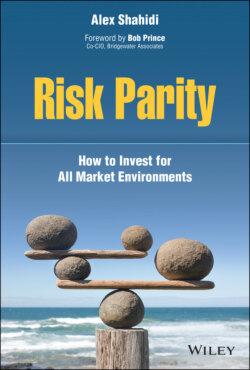Читать книгу Risk Parity - Alex Shahidi - Страница 21
WHAT IS RISK?
ОглавлениеThe rate of return of an investment is a relatively straightforward notion to understand. You invest $100 and in one year your portfolio is worth $110. This means you earned a 10% return. Risk, on the other hand, is multifaceted and more challenging to observe and measure. I think of risk across three different dimensions:
1 Volatility
2 Probability of catastrophic loss
3 Odds of an extended period of poor returns
Volatility is the standard measure of risk in the investment industry. The technical metric is standard deviation, which is a statistical of the dispersion of an investment's price change around its average over time. The more the price fluctuates around its average return, the greater the volatility. In general, a lower volatility is preferred over a higher volatility for the same return because the odds of actually earning the average return improve. This is because investors are less likely to get in and out at inopportune times.
A major shortcoming of the volatility metric is that a return stream can exhibit reasonable volatility most of the time, but suddenly experience a major loss of capital. That is, the average may be acceptable yet understate extreme negative outcomes. Many experts have commented that highly improbable results seem to occur far more frequently than statistically expected. In other words, the notorious “100‐year flood” seems to hit financial markets far more often than once every 100 years. We've witnessed firsthand some of these outliers in the last three decades alone, with the 1999 tech bubble and bust, the 2008 global financial crisis, and the 2020 global pandemic. For this reason, the probability of a catastrophic loss should also be analyzed when considering the risk of a strategy.
Last, a longer‐term perspective of risk is justified. Consider that the volatility and distribution may be acceptable, but the average return could be low for an extended period of time. That is, the odds of poor returns over a long period (e.g., the so‐called lost decade in 1990s Japan) may be the most relevant risk. After all, investors may be able to live through the roller‐coaster ride associated with a precipitous drop and subsequent rebound, but 10 years of severe underperformance may be difficult to overcome. This is particularly relevant for investors who rely on a certain rate of return to fund annual expenses.
A well‐balanced portfolio should be structured to minimize all three aforementioned risks for a desired long‐term return objective. All three risks are pertinent and worth consideration because each can have a material negative impact on investors.
